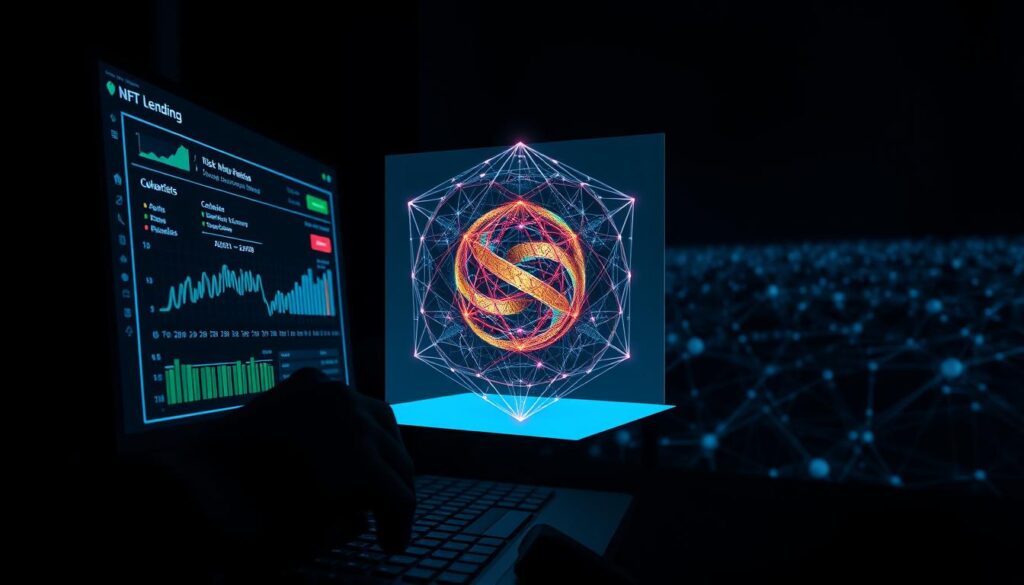Now Reading: NFT Lending Collateral Borrowing Protocol Explained
- 01
NFT Lending Collateral Borrowing Protocol Explained
NFT Lending Collateral Borrowing Protocol Explained

The world of digital collectibles has undergone a remarkable transformation. What began as a niche for art and profile pictures has evolved into a dynamic financial landscape. Unique tokens are no longer just items to be collected; they are becoming powerful tools within decentralised finance.
This guide explores how these digital assets are creating new opportunities. Holders can now unlock the value tied up in their prized possessions without having to sell them. This is achieved through innovative systems that facilitate lending and borrowing against these tokens.
The mechanics involve using an NFT as collateral to secure a loan. This process allows collectors to access liquidity while retaining ownership. It represents a significant shift in how we perceive and utilise digital assets.
From individual enthusiasts to large institutions, this new sector offers various applications. Understanding the infrastructure, risks, and potential is crucial for anyone looking to participate. This article will provide a clear and comprehensive explanation of this exciting development.
Key Takeaways
- Non-fungible tokens have evolved from simple collectibles into functional financial instruments.
- It is now possible to use your digital assets to secure loans without selling them.
- This lending process provides much-needed liquidity to holders of valuable NFTs.
- The underlying technology relies on smart contracts to ensure secure transactions.
- This sector presents opportunities for both individual collectors and institutional players.
- Understanding the risks and valuation methods is essential before participating.
Introduction to NFT Lending and Collateral Borrowing
Non-fungible tokens have journeyed far beyond their origins as digital art and profile pictures. The landscape has transformed significantly, with these unique digital items now being staked, rented, and used as financial security. This evolution marks the emergence of an entirely new sector within decentralised finance.
Defining NFT Lending and Its Evolution
Just a few years ago, digital collectibles offered limited financial utility. Owners could display their prized possessions but had few options beyond outright sale. The concept of nft lending emerged from recognising that staked items couldn’t generate additional returns.
This innovative system allows borrowers to use their digital assets as security for cryptocurrency or traditional currency loans. The items remain securely stored on smart contracts throughout the loan period. This approach unlocks liquidity while maintaining ownership rights.
The Shift from Traditional Collectibles to Financial Assets
The transformation from static collectibles to dynamic financial instruments represents a fundamental shift. Previously idle items in digital wallets can now produce value beyond potential appreciation. This expanded nft utility has created exciting new opportunities.
Gamers can borrow against in-game items, while artists earn steady income by leasing access to their work. DAOs pool capital for renting virtual land. The integration with decentralised finance protocols has unlocked previously unimaginable use cases.
| Aspect | Traditional NFTs | Financial Utility NFTs | Impact |
|---|---|---|---|
| Primary Function | Display & Collection | Capital Generation | Expanded Use Cases |
| Value Source | Scarcity & Aesthetics | Financial Returns | Diversified Revenue |
| Owner Benefits | Social Status | Liquidity Access | Financial Flexibility |
| Market Maturity | Early Stage | Established Sector | Broader Adoption |
This maturation reflects how value is increasingly derived from practical financial functions. The necessary infrastructure developed by specialised companies enables secure arrangements without centralised intermediaries. The hybrid financial product serves both ownership preservation and liquidity access.
Understanding NFT Lending Collateral Borrowing Protocol
The concept of ownership undergoes a significant evolution within these specialised financial systems. They create a structured bridge between holding a valuable digital asset and accessing immediate capital.

Key Features of the Protocol
This framework operates on several core principles. Automated smart contracts manage the entire process, ensuring security and transparency for all parties.
Predetermined loan-to-value ratios and clear interest rate mechanisms are standard. These features help manage risk for both the asset holder and the capital provider.
Flexibility is a major advantage. Participants can often choose from preset options for loan duration and other terms. This makes the system adaptable to different needs.
How Collateralisation Transforms NFT Ownership
Using a digital item as security fundamentally changes its purpose. Ownership shifts from a simple possession model to a functionally productive one.
Holders are no longer forced to choose between selling an asset or holding it idle. They can maintain their position in a collection while accessing liquidity for other uses. This is a key benefit of learning how to use these systems effectively.
The asset is typically locked in a secure digital vault for the loan’s duration. This ensures the lender’s security while the borrower uses the capital.
| Aspect | Traditional Ownership | Collateralised Ownership |
|---|---|---|
| Primary Utility | Collection & Display | Capital Access & Collection |
| Financial Flexibility | Limited (Sell to access value) | High (Borrow against value) |
| Risk Profile | Market Volatility Only | Market Volatility & Loan Terms |
This transformation represents a mature step for digital assets. It integrates them more deeply into the wider world of finance.
The Evolution of NFT Utility in DeFi
What was once considered purely decorative now serves as productive capital in decentralised ecosystems. This transformation represents a fundamental shift in how digital assets create and distribute value.

From Art and Avatars to Staked Assets
Initially, these unique tokens offered limited financial utility beyond speculative appreciation. They served primarily as digital art for display or profile pictures for identity.
The emergence of NFT-Fi introduced DeFi primitives to the ecosystem. Staked assets now allow holders to lock their tokens while earning rewards. This evolution enables participation in governance and exclusive benefits.
The Role of NFT-Fi in Unlocking Liquidity
NFT-Fi’s primary achievement lies in solving the fundamental problem of illiquid digital collectibles. It creates mechanisms through which holders can access capital without selling assets.
This trend towards financialisation has attracted institutional interest. Sophisticated investors now view these tokens as legitimate asset classes. They recognise the potential for generating yields and serving portfolio functions.
The integration enables complex financial strategies previously impossible. This includes income generation through rentals and participation in specialised liquidity pools. The broader evolution of utility continues to expand possibilities for holders across various sectors.
Mechanics of NFT Lending and Collateralisation
Automated agreements form the core infrastructure that powers modern digital finance systems. These programmed contracts handle the complete lifecycle of asset-backed financing arrangements.
Utilising Smart Contracts for Secure Transactions
Self-executing code eliminates traditional counterparty risks. The technology automatically enforces all terms without human intervention.
These sophisticated contracts manage collateral deposits and fund disbursement. They track repayment schedules and calculate accrued interest accurately.
Security remains paramount throughout the process. Reputable platforms undergo rigorous auditing before deployment.
Collateral Valuation and Loan Terms
Determining asset worth presents unique challenges in digital markets. Platforms employ various methods to establish fair value.
Some systems use decentralised oracles that aggregate marketplace data. Others implement peer-to-peer negotiation between participants.
| Valuation Method | Process | Best For | Limitations |
|---|---|---|---|
| Oracle-Based Pricing | Automated data feeds from major markets | High-volume collections | Less accurate for rare items |
| Peer Assessment | Direct lender-borrower negotiation | Unique or rare assets | Time-consuming process |
| Algorithmic Models | Historical sales and collection metrics | Established projects | Requires substantial data |
Loan-to-value ratios typically range between 30-50% of assessed worth. Interest rates reflect the risk profile of the underlying asset.
Blue-chip collections often secure better terms due to their stability. The system includes safety features like grace periods for margin calls.
Risk Management in NFT Lending Protocols
Operating within digital asset finance requires robust systems to handle unpredictable market movements. These frameworks protect all participants from potential losses while maintaining system stability.
Effective protocols implement comprehensive safeguards against various financial challenges. This approach ensures sustainable operations even during turbulent market conditions.

Assessing Volatility and Liquidation Concerns
Digital collectibles experience significant price swings that demand constant monitoring. Floor prices and trading volumes serve as crucial indicators for potential trouble.
When collateral value drops below loan amounts, liquidation processes activate. Platforms typically provide grace periods for borrowers to rectify undercollateralised positions.
BenDAO’s 48-hour window exemplifies this protective approach. Such measures balance lender security with borrower flexibility during market downturns.
Strategies for Mitigating Market Risks
Overcollateralisation remains the primary defence against value fluctuations. Borrowers pledge assets worth significantly more than their loan amounts.
Sophisticated platforms categorise collections based on liquidity and historical performance. They apply different loan-to-value ratios according to assessed risk levels.
Diversification strategies help lenders spread capital across multiple assets. This reduces exposure to collection-specific problems like project abandonment.
Some services integrate insurance mechanisms for additional protection. These measures create safer environments for all participants in the ecosystem.
Companies like Nexo demonstrate advanced risk management approaches through strategic partnerships. Their arrangement with Meta4 Capital shows how professional risk management strategies can hedge against liquidation losses.
Innovative NFT Rentals and Leasing Models
Digital ownership is experiencing a fundamental shift as rental models emerge. These systems allow temporary access to digital assets without requiring full purchase. This creates new economic opportunities for both collectors and enthusiasts.

Exploring Peer-to-Peer and Peer-to-Protocol Approaches
Two main frameworks dominate the rental landscape. Peer-to-peer systems enable direct agreements between asset holders and renters. Smart contracts manage the temporary transfer and ensure proper return.
Protocol-based models function differently. Owners deposit items into shared pools that users can access. Pricing is often determined algorithmically based on demand and availability.
Benefits of Perpetual NFT Rentals
Perpetual arrangements offer particular advantages for continuous access. Renters can use digital assets indefinitely through ongoing payments. This eliminates large upfront costs while providing sustained utility.
For owners, these models transform static collections into revenue sources. They establish passive income streams while maintaining ownership rights. The system works across gaming assets, virtual land, and exclusive communities.
Users gain entry to valuable ecosystems without significant investment. This democratises access to high-value digital spaces. The model represents a practical evolution in how we utilise digital collectibles.
Emerging Trends and Strategic Insights
Strategic innovations in the digital asset space are creating new paradigms for value extraction and capital formation. The evolution of financial mechanisms continues to transform how participants engage with unique digital items.
Cross-Chain Lending and Fractional Ownership
Cross-chain functionality represents a significant advancement for digital finance. This trend enables assets from different networks to serve as collateral across multiple ecosystems.
Fractional ownership models are gaining traction among investors. Multiple participants can now share ownership of high-value digital collectibles through tokenisation.
These platforms provide greater access to premium assets that were previously out of reach for smaller investors. The approach democratises investment opportunities in the crypto space.
Decentralised Governance and Future Predictions
Community-driven governance is becoming central to platform development. Token holders now influence key decisions through voting mechanisms.
Future predictions suggest deeper integration with traditional finance systems. This includes potential regulatory frameworks that could legitimise these emerging markets.
The trend toward real-world asset tokenisation indicates broader applications ahead. Digital representations of physical property may soon participate in lending protocols.
Interest rates and risk assessment tools are becoming more sophisticated through algorithmic analysis. This evolution enhances the overall stability of these financial platforms.
Conclusion
Digital asset holders now have unprecedented opportunities to generate value from their collections without relinquishing ownership. The financialisation of unique tokens has created powerful systems where users can access liquidity while maintaining their digital possessions.
These innovative platforms offer substantial benefits for collectors seeking passive income streams. Professional development company expertise becomes essential for building secure and competitive nft lending platform solutions.
The future promises even greater integration with traditional finance as blockchain technology matures. This evolution will likely make digital asset financing a standard feature of portfolio management.
For projects exploring this space, partnering with experienced development company specialists ensures robust implementation. Their comprehensive services cover everything from smart contract security to user experience design.
FAQ
What exactly is an NFT lending platform?
An NFT lending platform is a service that allows holders to use their digital assets, such as digital art or collectibles, as security for a loan. Users can access liquidity without selling their prized possessions, while lenders earn interest on their capital.
How does the collateralisation process work?
The process involves a holder locking their asset into a smart contract on the platform. This contract holds the item securely. The platform then assesses the asset’s value to determine the loan amount. The borrower receives funds and retains ownership, provided they repay the loan and interest.
What are the primary benefits for asset holders?
Holders gain immediate access to cash flow without a sale, enabling them to cover expenses or invest elsewhere. This model also creates opportunities for passive income. It significantly enhances the utility of assets that would otherwise remain idle in a digital wallet.
What risks are involved with using these services?
The main risk is volatility. If the market value of the secured asset drops sharply, it might trigger a liquidation where the asset is sold to cover the loan. Platforms employ various risk management strategies, but participants should understand the potential for loss.
Can I rent out my NFTs instead of borrowing against them?
Yes, the concept of NFT rentals is an emerging trend. Through specific smart contracts, you can lease your asset’s utility, such as in-game items or membership passes, to others for a fee. This provides another revenue stream without transferring ownership.
How are interest rates determined on these platforms?
Interest rates are typically set by market forces of supply and demand on peer-to-peer platforms. In peer-to-protocol models, rates might be algorithmically determined based on the asset’s perceived risk, loan duration, and overall liquidity available in the system.













